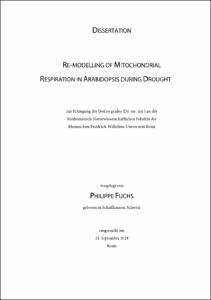Fuchs, Philippe: Re-modelling of Mitochondrial Respiration in Arabidopsis during Drought. - Bonn, 2019. - Dissertation, Rheinische Friedrich-Wilhelms-Universität Bonn.
Online-Ausgabe in bonndoc: https://nbn-resolving.org/urn:nbn:de:hbz:5-53721
Online-Ausgabe in bonndoc: https://nbn-resolving.org/urn:nbn:de:hbz:5-53721
@phdthesis{handle:20.500.11811/7879,
urn: https://nbn-resolving.org/urn:nbn:de:hbz:5-53721,
author = {{Philippe Fuchs}},
title = {Re-modelling of Mitochondrial Respiration in Arabidopsis during Drought},
school = {Rheinische Friedrich-Wilhelms-Universität Bonn},
year = 2019,
month = mar,
note = {Drought can severely limit growth and productivity of plants. To limit water loss by transpiration, plant leaves respond by reducing stomatal aperture. This simultaneously impairs CO2 uptake and can reduce carbon assimilation. Sustained irradiance in the absence of sufficient CO2 risks over-reduction of the photosynthetic and metabolic redox systems with potentially detrimental effects for the cell. In that situation, chloroplasts need to safely dissipate reductant for which several different mechanisms inside and outside the chloroplast have evolved. Mitochondrial electron transport can act as such an electron sink by reducing oxygen to water. The required capacity and flexibility to dissipate reductant are thought to be provided by uncoupling the electron flux to oxygen from the phosphorylation of ADP to ATP. Yet, our understanding of the significance, regulation and integration of the different uncoupling strategies in plant mitochondria is still limited. To investigate how (un-)coupling impacts drought acclimation, I have manipulated mitochondrial uncoupling capacity by combining mutants of Uncoupling Protein (UCP) and Alternative Oxidase (AOX1a). Phenotyping revealed slightly decreased drought tolerance and reduced leaf rosette areas of plants restricted in uncoupling, but differences were minor compared to published mutant phenotypes. Previous reports indicated altered cellular energy physiology in response to drought-related stresses. I sought to refine our understanding of the changes at subcellular level by monitoring selected key parameters in response to drought and related stresses using fluorescent protein biosensors. Despite consistent increases of ATP levels and more oxidised NAD in response to drought, subsequent monitoring of uncoupling mutants did not reveal differences between genotypes under any of the conditions tested. Surprisingly, dithiothreitol (DTT), a widely used chemical to induce reductive ER stress, strongly impaired root growth of aox1a and ucp1 uncoupling mutants. A connection between thiol-based reductive stress and mitochondrial electron transport flexibility has not been reported before, and was further investigated in isolated mitochondria. Measurements of oxygen consumption revealed increased respiration in response to DTT. Multiwell-based fluorimetric assays to monitor the proton motive force, pH gradient and membrane potential, and substrate depletion rates demonstrated that small thiol molecules can feed electrons into the electron transport chain. Based on the in planta and in organello insights, a refined model is proposed in which the mitochondria act as flexible cellular safe-guards against stress-induced cellular over- reduction not only by photosynthesis, but also by thiol-mediated reductive stress that may affect protein folding in the ER.
Considering the critical interplay between plant respiratory physiology and mitochondrial architecture in stress responses, the final section of this thesis investigates intramitochondrial pH compartmentation. The successful establishment of lines targeting the cpYFP pH biosensor to different mitochondrial compartments enabled in vivo measurements of pH gradients between plant mitochondrial subcompartments, suggesting a pH gradient of 0.4 units across the inner mitochondrial membrane.},
url = {https://hdl.handle.net/20.500.11811/7879}
}
urn: https://nbn-resolving.org/urn:nbn:de:hbz:5-53721,
author = {{Philippe Fuchs}},
title = {Re-modelling of Mitochondrial Respiration in Arabidopsis during Drought},
school = {Rheinische Friedrich-Wilhelms-Universität Bonn},
year = 2019,
month = mar,
note = {Drought can severely limit growth and productivity of plants. To limit water loss by transpiration, plant leaves respond by reducing stomatal aperture. This simultaneously impairs CO2 uptake and can reduce carbon assimilation. Sustained irradiance in the absence of sufficient CO2 risks over-reduction of the photosynthetic and metabolic redox systems with potentially detrimental effects for the cell. In that situation, chloroplasts need to safely dissipate reductant for which several different mechanisms inside and outside the chloroplast have evolved. Mitochondrial electron transport can act as such an electron sink by reducing oxygen to water. The required capacity and flexibility to dissipate reductant are thought to be provided by uncoupling the electron flux to oxygen from the phosphorylation of ADP to ATP. Yet, our understanding of the significance, regulation and integration of the different uncoupling strategies in plant mitochondria is still limited. To investigate how (un-)coupling impacts drought acclimation, I have manipulated mitochondrial uncoupling capacity by combining mutants of Uncoupling Protein (UCP) and Alternative Oxidase (AOX1a). Phenotyping revealed slightly decreased drought tolerance and reduced leaf rosette areas of plants restricted in uncoupling, but differences were minor compared to published mutant phenotypes. Previous reports indicated altered cellular energy physiology in response to drought-related stresses. I sought to refine our understanding of the changes at subcellular level by monitoring selected key parameters in response to drought and related stresses using fluorescent protein biosensors. Despite consistent increases of ATP levels and more oxidised NAD in response to drought, subsequent monitoring of uncoupling mutants did not reveal differences between genotypes under any of the conditions tested. Surprisingly, dithiothreitol (DTT), a widely used chemical to induce reductive ER stress, strongly impaired root growth of aox1a and ucp1 uncoupling mutants. A connection between thiol-based reductive stress and mitochondrial electron transport flexibility has not been reported before, and was further investigated in isolated mitochondria. Measurements of oxygen consumption revealed increased respiration in response to DTT. Multiwell-based fluorimetric assays to monitor the proton motive force, pH gradient and membrane potential, and substrate depletion rates demonstrated that small thiol molecules can feed electrons into the electron transport chain. Based on the in planta and in organello insights, a refined model is proposed in which the mitochondria act as flexible cellular safe-guards against stress-induced cellular over- reduction not only by photosynthesis, but also by thiol-mediated reductive stress that may affect protein folding in the ER.
Considering the critical interplay between plant respiratory physiology and mitochondrial architecture in stress responses, the final section of this thesis investigates intramitochondrial pH compartmentation. The successful establishment of lines targeting the cpYFP pH biosensor to different mitochondrial compartments enabled in vivo measurements of pH gradients between plant mitochondrial subcompartments, suggesting a pH gradient of 0.4 units across the inner mitochondrial membrane.},
url = {https://hdl.handle.net/20.500.11811/7879}
}






